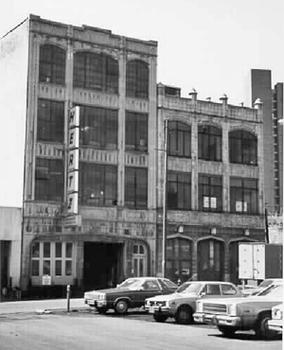Knickerbocker and Arnink Garages facts for kids
|
Knickerbocker and Arnink Garages
|
|
|
Formerly listed on the U.S. National Register of Historic Places
|
|

North (front) elevation of garages ca. 1980
|
|
| Location | Albany, NY |
|---|---|
| Area | 0.75 acres (3,000 m2) |
| Built | 1915 (Arnink), 1927 (Knickerbocker) |
| Architect | J. Walter Montross |
| Architectural style | Neo-Gothic |
| Demolished | 1989 |
| NRHP reference No. | 80002580 |
Quick facts for kids Significant dates |
|
| Added to NRHP | November 28, 1980 |
| Removed from NRHP | May 30, 1989 |
The Knickerbocker and Arnink Garages were two stone buildings in Albany, New York. They were built in the early 1900s. The Knickerbocker garage was added 12 years after the Arnink garage.
In 1980, these buildings were listed on the National Register of Historic Places. This means they were recognized as important historical sites. However, just nine years later, they were both torn down.
Many early garages were actually old stables or carriage houses. But the Arnink garage was different. It was built from an existing business building. Its owner ran a successful Ford dealership. He used the garage for car rentals and repairs.
Later, his superintendent bought the business. He then built the larger Knickerbocker garage. It was designed in the same style by the same architect.
These garages were among the first buildings in Albany made specifically for cars. Their Gothic-style fronts were unusual for the time. They might have been inspired by the nearby Delaware and Hudson Railroad office building. That building helped reshape downtown Albany. Today, it's the main office for the State University of New York.
One of the garages later became a warehouse. It was used that way until it was torn down. The demolition happened because of plans for new office towers nearby. Nothing has been built on the land since. It is now part of a parking lot for the Times Union Center.
What the Garages Looked Like
The two garages were in downtown Albany. They were on Hudson Avenue, between South Pearl Street and Green Street. The land there is mostly flat. The Hudson River is about 500 feet to the east. Today, this area is a large parking lot.
Across the street is a big parking garage. It serves the Times Union Center arena. An 18-story office tower is also nearby.
Both garages were built with strong steel frames and concrete. Their outsides were brick covered with special cast stone. The Knickerbocker garage was four stories tall. The Arnink garage was three stories tall. Both had flat roofs.
The Knickerbocker garage had a golden color. It looked like sandstone. The Arnink garage was gray, like granite. This was because of the different materials used in their stone.
Windows and Entrances
The windows on the upper floors of both garages were similar. They were large and shaped like pointed arches. The Knickerbocker's main entrance was a single, wide, pointed arch. It covered all three sections of the building. It had separate entrances inside.
The Arnink garage had a separate entrance for each section. Each had a pointed-arch entrance with an original folding door. A metal lantern-style light hung above each door. Above the Arnink's doors, the words "Arnink Garage 1915" were carved into the stone.
The garages had casement windows. These continued the pointed-arch style on the upper floors. The Arnink garage also had decorative bell-shaped tops called finials.
When the buildings were listed as historic, the Knickerbocker garage was a Hertz car rental place. It had a tall, lit-up Hertz sign on its front. This was the only big change made to either building over the years.
History of the Garages
In 1914, a plan to improve downtown Albany began. This led to the building of the Delaware and Hudson Railroad's new main office. Today, this is the State University of New York (SUNY) System Administration Building. This building was designed to look like a famous building in Belgium. It was meant to be a key landmark for traffic coming from Capitol Hill.
The new D&H building was very popular. Local business owners wanted their buildings to look similar. Henry Arnink, a local Ford Model T dealer, was one of them. He had expanded his business to include car repairs and rentals.
Arnink bought an existing three-story building at 74 Hudson Avenue. He then renovated and expanded it. Architect J. Walter Montross designed a Gothic-style stone exterior for it. This design might have been inspired by the nearby D&H Building.
Twelve years later, Arnink sold his business to his superintendent, Harry Knickerbocker. Knickerbocker wanted to make the business bigger. He hired Montross again to build a second garage. This new garage was similar to the first in its style and shape. The main difference was that it had an extra story. It also had one wide garage door at street level, with no text above it. It didn't have the bell-shaped tops either.
In 1947, Knickerbocker sold the Arnink garage. It was then turned into a warehouse. Both buildings were still in use when they were listed as historic places decades later. By then, Knickerbocker's business was a Hertz car rental franchise. This meant a large, lit-up Hertz sign was put on the front of the building. This was the only major change to the buildings after they were built.
By the late 1980s, the area around the garages was changing. Another historic building nearby had been torn down to make way for a new arena, the Times Union Center. In 1988, plans for two large office towers were approved for the area. Even though the garages weren't exactly where the new towers would be, they needed to be torn down for parking space. This happened in early 1989. The buildings were removed from the historic register a month later.
Images for kids



